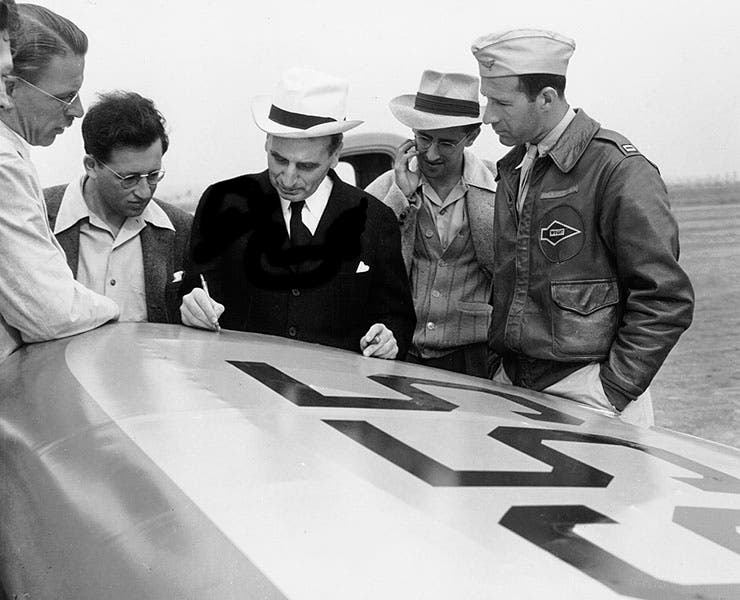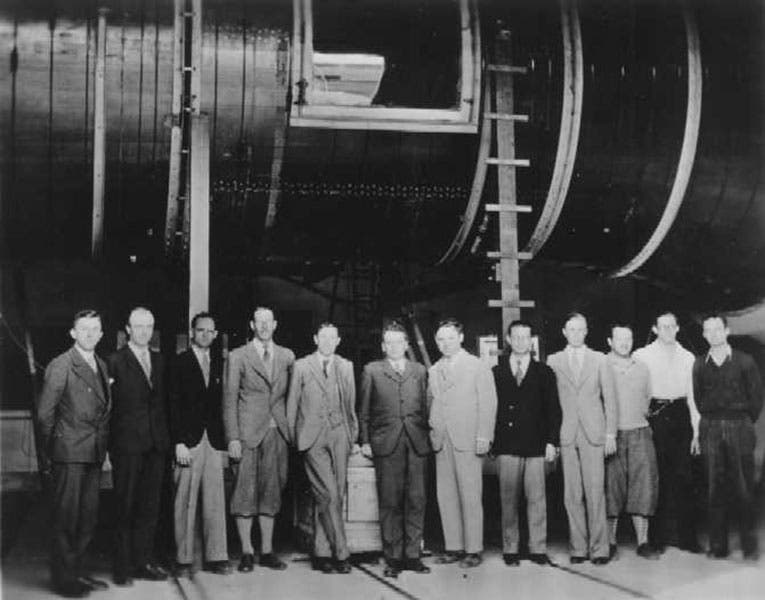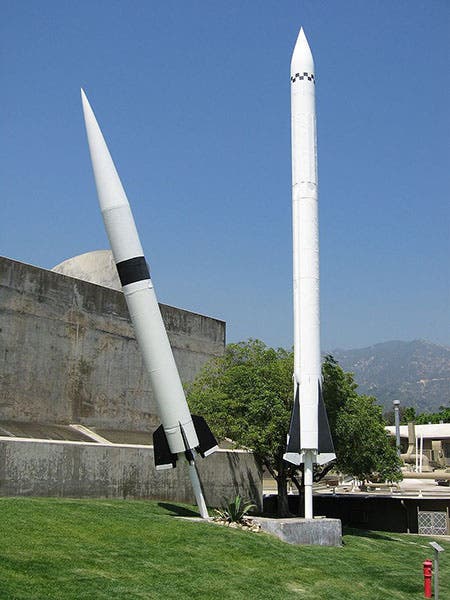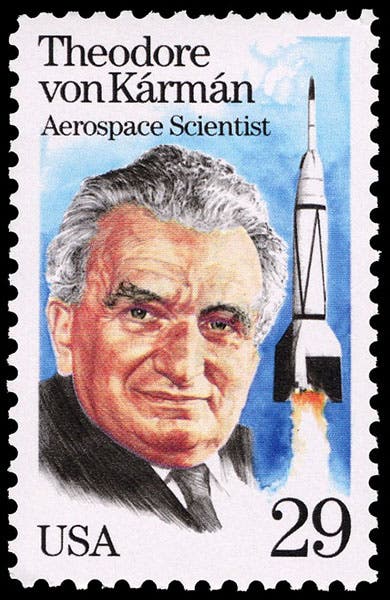Scientist of the Day - Theodore von Kármán
Theodore von Kármán, a Hungarian-American aerospace engineer, was born May 11, 1881. Von Kármán was raised in Budapest and became interested in the physics of flight as the aircraft age dawned in 1903. He studied aeronautics at Göttingen University and then became director of the Aeronautical Institute at Aachen. He was still there in 1926 when the Guggenheim family offered funds to establish a school of aeronautics at Caltech in Pasadena. Robert Millikan was in charge of setting up the new lab and went looking for someone to head it up. He had his eye on von Kármán from the beginning, but it took four years and several visits from von Kármán before he agreed to take the job in 1930. On one of his visits, von Kármán was asked to design a state-of-the-art 10-foot wind tunnel for the new Guggenheim Aeronautical Laboratory, which was in place by 1929 and must have been an attractive inducement. Millikan’s case was further helped by the fact that von Kármán, a Jew, realized that difficult times were ahead for Jews in Nazi Germany. The wind tunnel, by the way, filled a space 45 feet tall and 100 feet long and could produce wind speeds of nearly 200 mph. It would later be used to test most of the American fighter aircraft for World War II. We include a photograph of von Kármán and his team standing in front of the 10-foot wind tunnel in 1930 (second image).
It was a fortunate thing for aeronautics in the U.S. that von Kármán took the job. The Germans were far ahead of everyone in the fields of aeronautical engineering and aerodynamics – the study of the reaction of solid objects like wings to airflow. These were sophisticated mathematical and experimental sciences in Germany, and von Kármán was the first to bring that rigor to the United States, and to Caltech.
Von Kármán was not only a genius at aerodynamics, but he was blessed with a natural curiosity and a wide-open mind. In the 1930s, rocketry was the black sheep of aeronautics, a field that most engineers thought was a ridiculous waste of time. Early experimenters like Robert Goddard were scorned and set out to pasture. In 1936, von Kármán was willing to listen to one of his students, Frank Malina, who knew two young rocket enthusiasts, Jack Parsons and Ed Forman, who showed great promise in rocketeering, and von Kármán agreed to support them, not with money but with official backing and use of lab equipment and space, even though Parsons and Forman were not even students at Caltech. Officially now the Rocket Research Group, they were soon testing (but not firing) rockets in Arroyo Seco, a wash northeast of Pasadena, and attracting other rocket enthusiasts to the enterprise. This was the first university supported rocket program in the country.

Theodore von Kármán making notes on the wing of the Encoupe aircraft that is about to take off with rocket assist; Jack Parsons, who was not a Caltech student, has been cropped out of the photo at the left by the JPL publicity team. Frank Malina is between von Kármán and the pilot (Wikimedia commons)
When the War came, the U.S. government became interested in the work of the Rocket Research Group – not for weapons, or space exploration, but for take-off assist for aircraft. Von Kármán through Malina secured a small grant in 1939 from the National Academy of Sciences to develop suitable jet-assisted takeoff rockets (JATO) – called jet-assist instead of rocket-assist because the word ‘rocket’ was not a word one used to fund-granting agencies. Parsons and Forman worked hard to solve the problem of developing a solid fuel that would burn evenly and not explode – no easy task. They succeeded just in time for the first test, on Aug 12, 1941, when a small plane took off with half the normal length of runway, boosted with 4 JATO rockets, hand-packed the night before by Parsons and Forman (third and fourth images).
The Army was impressed, and the orders for JATO rockets grew so fast that in 1942, the JATO production group was incorporated as Aerojet Corporation with von Kármán as president, Malina as treasurer, and Parsons and Forman as vice-presidents, each of them putting up $250 as initial capital. The company soon grew into the world’s largest manufacturer of rockets.
At the same time, in 1943, von Kármán was briefed on what was known about the German V-2 rocket effort and asked for his advice; he suggested the formation of a government-funded, university-run lab to investigate the design and construction of mid- and long-range military rockets. Later that same year, the Jet Propulsion Laboratory (JPL) was founded, an institution funded by the Army and managed by Caltech. Von Kármán was the initial director, although he soon turned the directorship over to Frank Malina. JPL immediately began to design and test rockets. The first rocket they built was called the Private (1944), and they followed that up with the WAC Corporal (1945), and then the Sergeant (1955). These were the ancestors of the ICBMs of the late 1950s and the spacecraft-launching rockets of the 1960s and the 1970s. A Sergeant and a Corporal were until recently on display at JPL (fifth image). It is said that von Kármán was once visited by a general who was intrigued by the JPL practice of naming their rockets after military ranks, and he asked von Kármán how high up in rank they would go. Von Kármán supposedly replied, “Certainly no higher than Colonel. That is the highest rank that works.”
IN 1944, von Kármán was invited to advise the government on aeronautical matters, which is why he resigned his positions at both Aerojet and JPL (although continuing on as head of the Guggenheim Lab). He would consult much of the rest of his life – in fact, John von Neuman claimed that von Kármán invented the position of consultant. In 1963, von Kármán was awarded the first National Medal of Science by President Kennedy (sixth image, above). He died shortly thereafter, on a trip to Germany, nearly 82 years old. He was buried in Hollywood Memorial Park. A postage stamp was issued in his honor in 1992 (seventh image, below).
We have 22 books by and about von Kármán in the Library’s collections.
Originally posted May 11, 2016; revised May 11, 2021.
Dr. William B. Ashworth, Jr., Consultant for the History of Science, Linda Hall Library and Associate Professor emeritus, Department of History, University of Missouri-Kansas City. Comments or corrections are welcome; please direct to ashworthw@umkc.edu.











